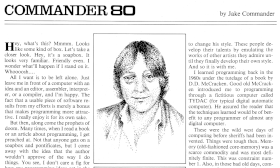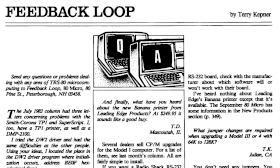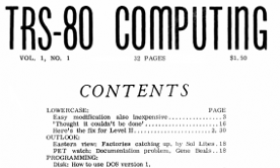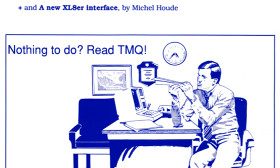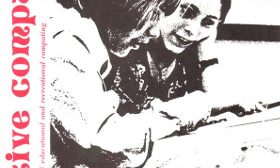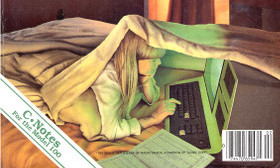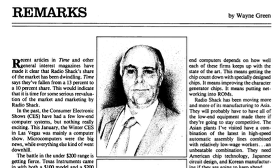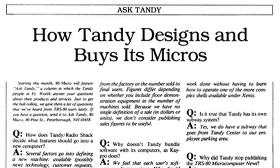Articles in the "Magazines" Category
“Commander 80” was a column that ran irregularly in 80 Microcomputing magazine from the May 1982 to the May 1983 issues. It was written by Jake Commander, TRS-80 author, technical consultant to 80 Microcomputing, and a very frequent contributor to the magazine. Despite the fact that there were only nine “Commander 80” columns, it remains one of the best remembered columns from the magazine.
Jake Commander described “Commander 80” as “a regular pot-pourri of TRS-80 facts, ideas, and opinions” in his first column:
This is the first of a series of columns I’ll be doing every month for 80 Microcomputing, covering topics ranging all the way from software and hardware to my general opinions on whatever takes my fancy. This is an opportunity I’ve waited for — to be able to sound off and air some of my views.
(Read more...)
“Feedback Loop” was a popular column in 80 Microcomputing magazine. It began in the June/July 1982 issue and ran until the magazine ended in 1988. “Feedback Loop” answered reader letters about “any questions or problems dealing with any area of TRS-80 microcomputing”. It was one of the best sources of TRS-80 information available at the time.
“Feedback Loop” was written by Terry Kepner for most of its run. It replaced “The Exclusive Oracle”, a similar column written by Dennis Báthory-Kitsz that also answered reader questions.
(Read more...)
TRS-80 Computing, also known as S-80 Computing, was an early newsletter for the TRS-80. It was published by Computer Information Exchange (also known as CIE) from 1978 to 1980. It cost $1.50 per issue or $15.00 for twelve issues. Although not very many issues of TRS-80 Computing were published, it was a highly regarded TRS-80 newsletter, described by Recreational Computing as “a top-rated publication.”
Computer Information Exchange was an educational nonprofit corporation that was based in San Luis Rey, California and founded by Bill McLaughlin. It sold a variety of low-cost TRS-80 software on cassette, mostly of an educational nature. Their most popular product was People’s Pascal, an implementation of the Tiny Pascal compiler that was created by Kin-Man Chung and Herbert Yuen. Computer Information Exchange sold two versions of People’s Pascal:
(Read more...)
“TRS‑80 Strings,” later known as “Tandy Gram,” was a column in Creative Computing magazine that focused on TRS-80 computers. It was written by Stephen B. Gray for most of its run and first appeared in the November/December 1978 issue.
Stephen B. Gray was best known for founding the Amateur Computer Society in 1966, a group for “anyone interested in building and operating a digital computer that will at least perform automatic multiplication and division.” Gray was also the publisher of the newsletter for the Amateur Computer Society (better known as the ACS Newsletter) that claimed to be (and probably was) “the first hobby-computer publication in the world.” The ACS Newsletter published 40 issues from August 1966 to December 1976.
(Read more...)
The MISOSYS Quarterly, better known as TMQ, was the official newsletter for MISOSYS, a software company based in Sterling, Virginia. It was published by Roy Soltoff, the “system designer of TRSDOS 6.0” and co-founder of Logical Systems (the creators of LDOS and LS-DOS). The MISOSYS Quarterly was far more than just a company newsletter, and was one of the best technical resources for the TRS-80 Model III and Model 4. Along with TRSTimes and Computer News 80, it was one of the last print publications for the TRS-80.
The MISOSYS Quarterly had similarities to an earlier MISOSYS newsletter, Notes from MISOSYS. But The MISOSYS Quarterly was far more ambitious, with outside advertising, articles by external authors, and information about non-MISOSYS products.
(Read more...)
Creative Computing was a very popular early computer magazine and was one of the few to predate microcomputers themselves. It was created by David Ahl and published its first issue in October 1974. David Ahl once described Creative Computing as “the first personal computing magazine.” Although it was created to promote educational computing, it became one of the best magazines for hobbyists.
While working at Digital Equipment Corporation, David Ahl edited EDU, a newsletter aimed at educational users of Digital Equipment’s computers. (This was also when he first published his book 101 BASIC Computer Games). EDU became quite successful as the use of computers in education expanded. But Ahl envisioned a more generic magazine for educational users of all computers, not just those sold by Digital Equipment. When Ahl left Digital Equipment in July 1974, he developed this idea into Creative Computing
(Read more...)
For three years starting in 1982, the TRS-80 magazine 80 Micro held a contest to encourage young people to program. It was known as the “80 Micro Young Programmer’s Contest.” Anyone under the age of 18 could submit a program for a chance at winning prizes. 80 Micro published the winning contest entries in the February issue each year.
The entries, which numbered over 200 the first two years, were judged by the 80 Micro editorial staff based on five categories: programming elegance, documentation, originality, error-trapping, and usefulness. Most of the winning entries were written for the TRS-80 Model I and III, but there were also several for the Color Computer, and even one each for the Model II, Model 4, and Model 100.
(Read more...)
Kilobaud Microcomputing was a hobbyist computing magazine that began in 1977. It was created by Wayne Green, who was known for publishing the magazines 73, BYTE, and later 80 Microcomputing. Kilobaud Microcomputing was aimed more at the beginning computer hobbyist than other similar magazines. It is perhaps best known for spinning off 80 Microcomputing, the most popular TRS-80 magazine.
The magazine was originally named Kilobaud when it began in 1977. That changed to Kilobaud Microcomputing by the January 1979 issue. The word “Kilobaud” on the cover became smaller and disappeared entirely in 1982. The magazine was then called Microcomputing until it ended in 1984.
(Read more...)
“80 Remarks” was a column that ran in 80 Microcomputing from the first issue in January 1980 until September 1983. It was written by Wayne Green, the publisher and founder of 80 Microcomputing. The column name was shortened to just “Remarks” in October 1982.
Wayne Green published several magazines at the time and wrote a different column in each. His column was “Never Say Die” in 73, “Publisher’s Remarks” in Kilobaud Microcomputing, “Off Color” in Hot CoCo, “Hot Cider” in inCider, and “80 Remarks” in 80 Microcomputing.
Wayne Green set the tone for “80 Remarks” with his first column:
First, I want to make it clear that this magazine is not connected with Radio Shack or Tandy. I call ’em as I see ’em and don’t pull the punches. Where Radio Shack deserves credit, they’ll get it. Where I think they are screwing up, I’ll be blunt about that. I don’t ask that you like me–that’s your problem, not mine. I like you and I will be working for your best interests… and so will the magazine.
(Read more...)
“Ask Tandy” was a column that appeared in 80 Micro from the November 1984 to the September 1985 issues. It was described as “a column in which the Tandy people in Ft. Worth answer your questions about their products and services.” “Ask Tandy” was an official source of TRS-80 information from the notoriously secretive Radio Shack.
Because 80 Micro was the most popular magazine (by far) for Radio Shack TRS-80 users, cooperation from Radio Shack might have seemed like an obvious idea. But the relationship between Radio Shack and 80 Micro had always been strained, particularly while Wayne Green was still publisher.
(Read more...)
“80 Applications” was a popular column that first appeared in the January 1980 premiere issue of 80 Microcomputing. Written by Dennis Báthory-Kitsz, “80 Applications” covered a wide range of TRS-80 related hardware projects and ideas.
The first “80 Applications” column was only one page but it soon grew to become one of the most detailed columns in 80 Microcomputing. As that initial column promised:
In the coming months, this column will present unusual applications of the TRS-80 in everyday and not-so-everyday life. Hardware and software extensions and fixes will be described, and some of the fascinating inner workings of this first computer-for-the-people will be revealed.
(Read more...)
“Fun House” was one of the best remembered columns that ran in 80 Micro magazine. It was written by Richard Ramella, author of the 1982 book Computer Carnival: Sixty Programs for Starters". “Fun House” first appeared in the September 1982 issue of 80 Micro and ran until April 1984, with one gap for the February 1984 issue.
Computers were still a scary unknown for many at the time and “Fun House” encouraged people to have fun with computers. Ramella used his gentle style to focus on a different theme each month:
(Read more...)
One of the most popular columns in the TRS-80 magazine 80 Microcomputing wasn’t about the TRS-80 at all. In fact, despite appearing to be a news column, it wasn’t about real products or companies. It was “News From Kitchen Table Software, Inc.”, a very amusing humor column introduced by David Busch in the July 1981 issue.
“News From Kitchen Table Software” followed the fictional company Kitchen Table, Inc. (also known as KTI), described as “United States’ largest fictitious supplier of space-age computer products.” Kitchen Table was founded by the equally fictitious Scott Nolan Hollerith.
(Read more...)
BYTE: The Small Systems Journal was one of the longest running computer magazines and also one of the most popular. It was published from September 1975 to July 1998 and at one point in the 1980’s was the largest magazine in the country. In addition to the United States version, there were also twenty licensed editions of BYTE published in other countries.
BYTE was described by editor Carl Helmers in the premiere issue as “a monthly compendium of information for the owners and users of the new microcomputer systems becoming widely available at moderate cost.” It began at the start of the microcomputer revolution, even before mass-marketed computers were widely available, but also spanned into the age of the Internet and the World Wide Web.
(Read more...)
SoftSide was a popular computer magazine that covered multiple computer platforms, including the TRS-80, Apple II, Atari, Commodore 64, and IBM PC. But when Roger Robitaille published the first issue in October 1978, SoftSide focused on only one computer: the TRS-80 Model I.
That first issue, which identified itself as “your BASIC software magazine,” began with this statement:
There are those who might say we’ve got rocks in our heads for starting another computer magazine in the first place. We even wondered about it ourselves—but only for a minute.
Personal computing has taken a new direction. The technological wonder of the early ‘70’s has come out of the basement workshop and into the living room. People are coming to look upon the computer less as the ultimate machine, the hobby in itself, and more as the tool, the medium, the vehicle for the real stars—our ideas and imagination.
Our intention is to publish software—and lots of it, free for the transcription. Every month we will offer programs for business, games, programs with household applications, even educational programs for children that will allow your home computer to become the educational aid we always knew it could be. Our content will be as diverse and unique as our featured program’s writers.
(Read more...)
80 Microcomputing, also known as 80 Micro, was the most famous of the TRS-80 magazines and the best remembered. It was the first of the platform-specific computer magazines to become very popular, creating a model that many other magazines followed. Harry McCracken, former editor-in-chief of PC World, described PC World as “essentially an 80 Micro clone that happened to be about Windows, not TRS-80’s.”
80 Microcomputing published for 101 issues from January 1980 to June 1988, plus one special anniversary issue in 1983. With the combined June/July 1982 issue, 80 Microcomputing was renamed to 80 Micro and the cover date was advanced one month.
The magazine was very successful and spawned:
(Read more...)
Like most early microcomputer magazines, 80 Microcomputing published many reader submitted programs. These programs were among the most popular features of the magazine but needed to be typed into a computer before they could be used. Typing in long program listings was time consuming and there was always the real possibility of introducing errors during the typing process.
Selling a tape containing the programs from 80 Microcomputing was an idea mentioned almost from the beginning of the magazine. That idea eventually led to the product named LOAD-80. Wayne Green, the publisher of 80 Microcomputing, first referred to LOAD-80 in his “80 Remarks” column in the April 1981 issue:
(Read more...)
“The Assembly Line” was a column about assembly language programming which first appeared in the April 1980 issue of 80 Microcomputing. It was written by William Barden, well known for his books about assembly language such as the Z80 Microcomputer Handbook, TRS-80 Assembly Language Programming, and Programming Techniques for Level II BASIC. The first “Assembly Line” column began with these words:
This is the first of what I hope will be many columns devoted to TRS-80 assembly language programming. Judging from articles I’ve read and comments I’ve heard at users’ groups, many of you are interested in assembly language. I’ll provide tutorial material on the more difficult aspects of assembly-language routines that you can use with BASIC programs or other assembly-language code.
(Read more...)
H&E Computronics, Inc. was well known for their line of business software for the TRS-80 and other computers, including programs such as VersaReceivables and VersaLedger. But they were probably best known for their TRS-80 monthly magazine, which billed itself as “the original magazine for TRS-80 owners.” It was called by a number of different names over its publication history, including TRS-80 Monthly Newsletter, TRS-80 Monthly Magazine, and H&E Computronics Monthly News Magazine. But most people knew it as H&E Computronics Magazine or just H&E Computronics.
The first issue was published in July 1978 as TRS-80 Monthly Newsletter with this mission statement:
The purpose of the TRS-80 Monthly Newsletter is to provide and exchange information related to the care, use, and application of the TRS-80 computer system.
(Read more...)
The “New Products” section in the TRS-80 magazine 80 Microcomputing was a listing of new product releases, described this way:
The New Products section is intended to inform our readers of new products on the market. All information in the section is taken from product releases sent by manufacturers.
But starting in 1982, every April issue included several gag products mixed in with the usual announcements. Here are just a few of those “April Fool’s” new products.
(Read more...)
The Alternate Source, also known as The Alternate Source Programmer’s Journal or TAS, was a well-remembered and very technical TRS-80 publication. Later billed as “The magazine of advanced applications and software for the TRS-80,” the first issue was published by Joni Kosloski and Charley Butler in January 1980. It was published once every two months for a total of six issues a year.
The concept behind The Alternate Source originated in October 1979. The Alternate Source was also the name of a company run by Butler and Kosloski that sold TRS-80 books and software. TASMON (The Alternate Source Monitor) was one of their more popular software packages. They also sold The Alternate Source in book form, with each year’s issues collected into one volume.
(Read more...)
Computer User was a short-lived TRS-80 magazine created by the publishers of Interface Age, a popular computer magazine that began in 1976.
Unlike many other TRS-80 magazines, Computer User was a professional, glossy publication from its first issue in November 1983. It was heavily promoted, with promotional copies of the premiere issue sent to subscribers of competing magazines.
(Read more...)
80-U.S. Journal was the best remembered name for a TRS-80 magazine that was published by 80-Northwest Publishing from 1978 to 1984. It was also published under the names 80-Northwest Journal and Basic Computing. Until 1982, it was published bimonthly (six issues a year) but it increased to monthly (twelve issues a year) after that.
80-Northwest Journal (sometimes called 80-NW Journal) was first published in 1978 with the September/October issue. The founder of the magazine, Irvin “Mike” Schmidt, described the reason behind the new publication in the first issue:
(Read more...)
Back in 1983, Lemons Tech and KWIK Software advertised a one issue joint newsletter named the Cassette Gazette. The Cassette Gazette described the products sold by the two companies, mixed with operational advice and interesting facts about using cassettes with the TRS-80. It appears to have been written by Wayne Lemons, the founder of Lemons Tech. I received my copy back in 1983, and it has always been a favorite of mine.
(Read more...)
“The Next Step” was a popular column written by Hardin Brothers that began in the February 1983 issue of 80 Micro. Originally conceived as a five part column about integrating BASIC and assembly language, “The Next Step” went on to become one of the longest running columns in the magazine.
The focus of “The Next Step” was programming the TRS-80 in assembly language. It covered the Model I and Model III at first, but had largely switched to the Model 4 by 1984. The name was a reference to assembly language as being the next step beyond BASIC, as was stated in the first column:
(Read more...)
The TRS-80 Microcomputer News was Radio Shack’s own official publication supporting the TRS-80, sent for free to anyone who bought a TRS-80 computer. The motto described it as “The microcomputer newsletter published for TRS-80 owners”.
Originally called the Radio Shack Microcomputer Newsletter, the first issue, published in 1977, was four pages long. It was published irregularly after that (two issues in 1978 and seven in 1979) until it changed to a monthly publication schedule with the October 1979 issue. It remained monthly from then on, with the exception of three combined issues in 1980 and 1982. The name changed to the TRS-80 Microcomputer News with the March/April 1980 issue.
(Read more...)
Dr. Dobb’s Journal was one of the longest running microcomputer magazines, lasting 33 years in print form. It was first published in January 1976 as Dr. Dobb’s Journal of Computer Calisthenics & Orthodontia with the subtitle “Running Light Without Overbyte”. The title of the magazine was eventually shortened to Dr. Dobb’s Journal.
The name “Dr. Dobb” didn’t refer to a real person but was created by combining the first names of Bob Albrecht and Dennis Allison, the founders of the magazine. The magazine was originally created to promote the concept of Tiny BASIC, a small but powerful BASIC interpreter that could be used on the new microcomputers such as the Altair.
(Read more...)
“The Gamer’s Cafe” was a column about TRS-80 gaming which ran in 80 Micro magazine. It first appeared in the November 1982 issue near the height of the TRS-80 game market and ran until April 1984. “The Gamer’s Cafe” had some similarities to “Captain 80,” a column written by Bob Liddil that premiered in the first issue of 80 Microcomputing in 1980 and later appeared in 80-U.S. Journal.
With only a few exceptions, “The Gamer’s Cafe” was written by the fictional character of Rodney Gambicus. The column started when Rodney and his friend Winthrop Luzerdraw decided to travel the country in a Ford Econoline van. They filled the van with TRS-80 computers and games, including multiple Model I’s, Model III’s, Color Computers, and two Pocket Computers that the Radio Shack dealer threw in as part of the deal. They also had a PMC-80 which they described as a “PMC ½.” Their plan was to stop at various locations around the country, put out tables, and let people play TRS-80 games, literally a “Gamer’s Cafe.”
(Read more...)
After the decision by the publishers of
80 Micro magazine to end TRS-80 coverage, there was a demand for new sources of TRS-80 information.
TRSLINK was first proposed by Luis M. Garcia-Barrio, sysop of a bulletin board system in Philadelphia. In many ways, the concept resembled the old
CLOAD magazine. It was envisioned as an electronic magazine for TRS-80 users, but not as a replacement for existing magazines. Each issue could fit on one 5 1/4" disk (although some later issues required a double-sided disk). Article submissions from users were welcomed, and any advertisements submitted were included for free. Unlike
CLOAD, distribution was provided for free via bulletin board systems, FidoNet, Usenet, and GEnie.
(Read more...)
After learning that 80 Micro was planning to drop TRS-80 support, Lance Wolstrup decided to launch his own magazine which he named TRSTimes. As he stated in the first issue:
“What I wanted was a newsletter whose roots and traditions were firmly planted in the Wayne Green tradition of 80 Micro from 1981 to 1983; one that would be primarily oriented toward the TRS-80 hobbyist.”
(Read more...)
